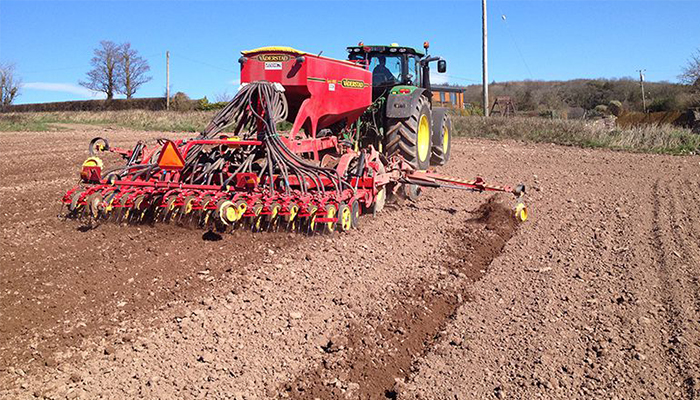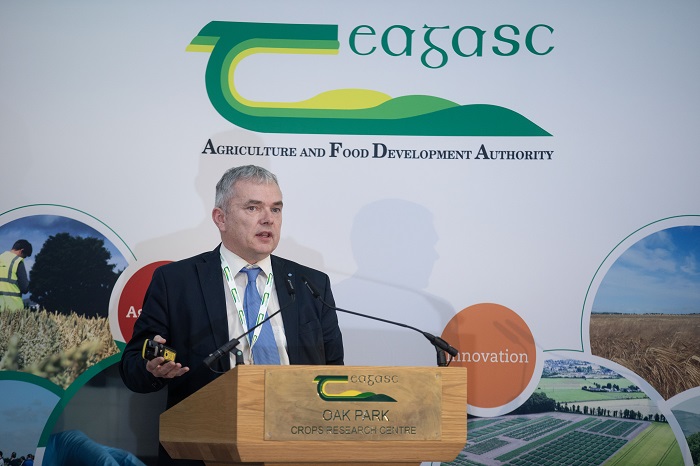02 February 2024
Careful assessment required before committing to re-sow

Tillage farmers have been advised to assess their crops carefully before committing to re-sow. That was one of the key messages from Teagasc Crops Specialist, Shay Phelan who spoke at the Teagasc National Tillage Conference on January 31.
Factors such as plant numbers, sowing date, tiller numbers, soil fertility and field conditions all need to be considered.
“When we look at our crops before the season really kicks off, we should really decide on our agronomy strategy for those crops based on what we see in front of us and plant counts should be carried out now.
“Once you have those plant counts, you can then decide what type of agronomy package you are going to bring forward to the crop – whether it’s a normal strategy based on achieving normal yields or whether you alter that strategy to reduce your inputs to try and give yourself a chance of making money on the crop. It’s not about how well the crop looks, it’s about how to make money on the crop. And the third option is whether you re-plant or not,” Shay told the delegates in attendance.
Touching on the plant counts required when doing the assessment to implement the appropriate agronomy package, Shay added: “It comes down to the area of the field that’s missing. Unfortunately with all these things, it is not even. There are patches here, there and everywhere, so you have to try and decide over the whole area of the field is it viable to take out or not.”
Table 1: Winter cereal plant count/m2 and the agronomy options
| Agronomy strategy* | Wheat | Barley (2 row) | Barley (6 row) | Oats |
|---|---|---|---|---|
| Normal | 200+ | 250+ | 170+ | 275+ |
| Altered | 90-200 | 150-250 | 100-150 | 150-275 |
| Replant? | <90 | <150 | <90 | <90 |
For those doubtful of the success of the altered agronomy strategy, Shay used DAFM trial work carried out on the winter wheat variety Garrus in 2018 as an example of how sub-optimal plant counts can still produce sufficient yields. Under this trial work, a plant count of 60-80 plants/m2 was established and carried through to harvest at DAFM trial sites throughout the country. At harvest, Garrus achieved 85% of control yields, albeit the plants were spaced evenly and given extra attention.
“In that year, across all the sites the Department were working on, Garrus averaged ~85% of the yield of the control in those trials. It does highlight the idea that you don’t necessarily have to rip out everything and that the crop – given time – can recover and establish decent yields.” Shay said.
Maximising returns from sub-optimal crops
Where altered agronomy programmes are being used, Shay encouraged farmers to tailor phosphorous (P) and potassium (K) inputs to the potential yield of the crop. By doing this for a 7.5t/ha versus a 10t/ha winter cereal, there’s the potential to save €45/ha (see table 2 for full details).
“If you know a crop has lower yield potential, it doesn’t have the same demand for N, P and K so you can take a decision to reduce costs and fertiliser inputs – the logical thing to do. That gives you a saving straight away and you are not trying to make the crop cover that extra cost and you are giving the crop a better chance of giving you a margin at the end of the day,” Shay said.
Although some farmers may be tempted to front-load nitrogen on struggling winter crops, Shay discouraged this practice, adding: “This is something we need to be careful of. When you are putting on that nitrogen early in the season, there needs to be growth there. There is absolutely no point in trying to drive the crop very early with no growth there because the chances are you will lose some of that nitrogen and, given the climate we are in at the moment, that’s not the place to be.”

Shay Phelan speaking from the Teagasc National Tillage Conference 2024
Re-sowing winter cereals with spring crops
For farmers considering re-drilling when sufficient plant counts aren’t present to implement the normal or altered agronomy strategy, Shay explained that they most assess the potential of the re-sown spring crop to leave a margin. Factors such as the field’s rotation and any previous spray programmes must also be considered.
“You should assess your crops before committing to re-sow. I think that is fundamental. Before you go and start re-sowing, you need to make sure that it’s worth re-sowing and assess those crops critically,” Shay said.
Using the costings from the Crops Costs and Returns 2024, the total variable costs and breakeven yields required are presented in table 2 below. The spring costs presented below also include the cost of the initial winter sowing, the winter seed and the costs of re-drilling the crop.
Table 2: Re-sowing winter cereals with spring crops
| Winter wheat | Spring wheat | Winter barley | Spring feed barley | Spring malting barley | Spring oats | Spring beans* | Spring peas* | |
|---|---|---|---|---|---|---|---|---|
| Total variable costs (€/ha) | 1,711 | 1,679 | 1,629 | 1,568 | 1,555 | 1,545 | 1,314 | 1,271 |
| Breakeven yield (t/ha) | 8.1 | 8.0 | 8.1 | 7.8 | 5.8 | 8.1 | 5.3 | 4.9 |
Spring crops variable costs include winter cereal seed and re-sowing. *Assumes no rotation or herbicide issues and protein payment of €400/ha
Commenting on the figures outlined in the above table, Shay said: “The one crop that really stands out there – if you are lucky enough to have a contract and get it passed – is malting barley. To me, that is the crop that is most likely to give you a decent margin over the other crops.
“The rest of them, it is really a toss of a coin and it really comes down to the situation within the field in terms of what’s there, what do I need to plant, what’s soil like and what’s the field like.”
Shay concluded his presentation by reminding farmers to assess their crops carefully before committing to re-sow and to re-drill based on economics not aesthetics.
Access Shay’s full presentation in PDF format from the Teagasc National Tillage Conference here.
Also read: Buffer strips and tillage farming – the benefits and regulatory requirements
Also read: Survey results: 38% of winter area unsown
Also read: Winter wheat varieties can be successfully sown up to mid-February
